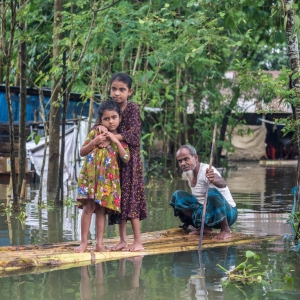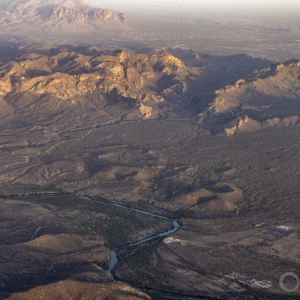This week’s episode of What’s Up With Water covers a setback to the environmental rights of nature in Florida and a recent lawsuit against the U.S. Environmental Protection Agency. Plus, Circle of Blue breaks down the top five must-know facts about drought in the American West.
Transcript
Welcome to “What’s Up With Water” – your need-to-know news of the world’s water from Circle of Blue. I’m Eileen Wray-McCann.
In Florida, a state judge delivered a setback to grassroots environmental movements. Circuit Court Judge Paetra Brownlee struck down an amendment to the Orange County Charter that protected lakes, wetlands, and streams from pollution by granting those waterways a legal right to exist. The county’s “rights to nature” amendment was passed overwhelmingly by Orlando-area voters in 2020 by a nine-to-one margin. The vote of approval came four months after the Republican-led Legislature tried to prevent similar local movements from starting. Lawmakers put a clause into an omnibus bill that prevented local governments from giving the natural environment its own legal rights. In her opinion, Judge Brownlee referenced the omnibus bill, writing that the Florida Legislature holds the power to set environmental policy and preempt county and local laws. Supporters of Orange County’s rights to nature amendment said they were unsure of their next steps but could appeal the decision.
In other legal news, the U.S. Environmental Protection Agency faces a lawsuit over its recent action in response to PFAS chemicals in drinking water. In June, the agency issued non-binding health advisories for four of the so-called ‘forever chemicals.’ Now the agency is being sued by one of the companies that makes the chemicals. E&E News reports that the lawsuit from the Chemours Company targets the EPA’s health advisory for the chemical GenX. The company alleges that the EPA’s advisory “lacked scientific integrity” by overstating the harm of GenX in drinking water. No PFAS chemical is currently regulated under the Safe Drinking Water Act. But the agency is developing binding regulations for two of the chemicals, PFOA and PFOS. Draft versions of the rules are expected this fall.
This week Circle of Blue highlights five things to know about the drought in the American West.
The drought is tragic and tenacious. But could it also be transformative?
The dry conditions parching much of the American West are setting records nearly every week. Lakes Mead and Powell, the country’s largest reservoirs, dropped to new lows this year. The Great Salt Lake did as well. This spring, New Mexico endured its largest wildfire ever. And even these extremes may be but a prelude. The hottest months of the year are still to come.
Shortened time frames are now the norm. In the Colorado River basin, water cuts that were once nearly unthinkable even in the long term are now happening in a matter of months, not years or decades. Even so, some see opportunity in calamity, a chance to reposition the region for the trials to come.
John Entsminger, is the general manager of the Southern Nevada Water Authority. On June 14, he addressed a Senate panel, saying “While the situation is objectively bleak, it is not in my view unsolvable,” Officials in the Colorado River basin are preparing to negotiate on water use, knowing that the time, like the water, is limited. The negotiations will be intense. This could be a season of long-lasting change for some of the country’s fastest-growing states and largest economies.
Here are five things to know about how drought is re-writing the story of America’s drylands.
1) It’s a Hot Drought
The drought is not just a failure of precipitation. The region’s rivers are also being depleted by rising temperatures due to global warming. The mechanisms are rather straightforward. Extreme heat bakes the land surface, even as the warmer, drier air absorbs and retains more water. That means less available water for soils, so when rain and melting snow do occur, the parched ground sucks up the water before it reaches rivers and reservoirs. In addition, a thirsty atmosphere also takes its share through evaporation. Between the soil and the sky, the heat is driving up drought.
2) Drought Has a Long Reach
When water stops flowing, the difficulties ripple outward. Forests become tinder boxes, a mere spark away from disaster. There have already been massive disruptions. In April, the U.S. Forest Service lost control of a prescribed burn in Santa Fe National Forest. It became the Hermits Peak-Calf Canyon fire, the largest wildfire on record in New Mexico, claiming over 340 thousand acres.
When water levels drop, hydropower is weakened. With less water in reservoirs, generators crank out fewer megawatt-hours, raising the cost of electricity and increasing the risk of summer blackouts. In California last year, hydropower generation was nearly half the 10-year average. This year, Glen Canyon Dam is generating just 60 percent of its peak electrical output since Lake Powell is so low.
Depleted lakes affect human health. Earlier this month, the Great Salt Lake fell to its lowest level since record-keeping began in 1847. Receding shores expose more lakebed salts and dust, which are a respiratory hazard during windstorms.
And ecosystems are also under stress. Utah regulators see high numbers of toxic algae in the southern reaches of Utah Lake, a water body notorious for summer algae outbreaks. These hazardous outbreaks usually get worse as summer settles in.
3) Water Cutbacks Are Inevitable
When supply ebbs and reservoirs dip near record lows, authorities have a common response: reduce demand.
And that is what’s happening, in fits and starts. In June, California regulators passed an emergency order that took small steps to balance supply and demand. The order prohibits businesses, industries, schools, churches, and other institutions from using potable water on grass that is considered “non-functional,” like the kind in median strips and office parks.
But even “functional” land is feeling the pinch. Cities and farms relying on the two major canals in California have already had their allocations substantially reduced because reservoirs are below average. With less water, irrigators will cultivate less land.
The largest cuts, however, will be in the Colorado River basin. Camille Touton, the commissioner of the Bureau of Reclamation, said in June that the seven states in the basin have to pull less water from the Colorado River, reducing their withdrawals by up to four million acre-feet in the next year. Their plan is due next month.
4) Drought Is Political
The right to use water in the western states is subject to convoluted laws, court decrees, and precedents, some of which date back to colonial times. Those old established norms are being reexamined by residents and lawmakers in response to persistently dry conditions and a recognition of historical inequities.
In June, the Nevada Supreme Court upheld a groundwater use plan for Diamond Valley irrigators that abandons long-held principles of state water law, such as the priority system that privileges senior water rights and the “use it or lose it” requirements.
In Arizona, activists are gathering signatures to put groundwater regulation on the ballot. Their citizen’s initiative would ask voters to approve two Active Management Areas in Cochise and Graham counties, places where large farming operations have dried up shallow wells and caused the ground to fracture, damaging highways.
In California’s Central Valley, the highways are dotted with billboards proclaiming “Dams Not Trains.” It’s a plea by the region’s largest farmers, who want legislators to redirect spending. At the same time, a budget proposal in the California Legislature would allocate $1.5 billion to buy senior water rights from farmers in order to keep more water in rivers.
And across the American West, Indian tribes are increasingly involved in the political landscape of water. Acting as dealmakers, tribes have emerged as key players in water supply negotiations, particularly in Arizona, where the Gila River Indian Community has leased water to cities and pledged significant conservation this year to boost water levels in Lake Mead.
5) Drought Is Probably the Wrong Word
Some researchers and advocates say we shouldn’t even be calling this a drought. Drought, they say, implies a temporary condition, a deviation from normal. But what is happening in the Colorado River basin and other western regions is a shift in what is normal, one toward a drier climate.
Even though precipitation in this two-decade period is anomalously and historically low, climate modeling suggests that the region is not going to snap back to the wetter periods of a generation ago.
Experts describe this new climate trajectory as aridification. They argue that what we call this trend can influence how we see the problem and what we do about it – which just might help to change behavior on a scale large enough and swift enough to meet the challenge.
And that’s “What’s Up With Water” from Circle of Blue, where water speaks. More water news and analysis await you at circleofblue.org. This is Eileen Wray-McCann – thanks for being here.
Eileen Wray-McCann is a writer, director and narrator who co-founded Circle of Blue. During her 13 years at Interlochen Public Radio, a National Public Radio affiliate in Northern Michigan, Eileen produced and hosted regional and national programming. She’s won Telly Awards for her scriptwriting and documentary work, and her work with Circle of Blue follows many years of independent multimedia journalistic projects and a life-long love of the Great Lakes. She holds a BA and MA radio and television from the University of Detroit. Eileen is currently moonlighting as an audio archivist and enjoys traveling through time via sound.





 © J. Carl Ganter / Circle of Blue
© J. Carl Ganter / Circle of Blue